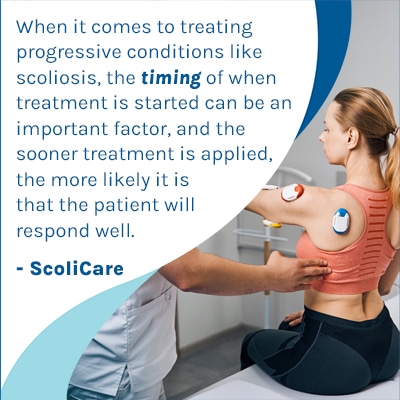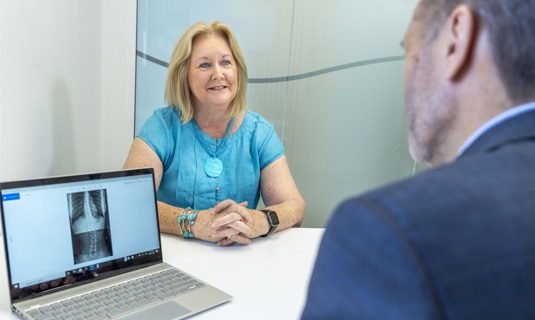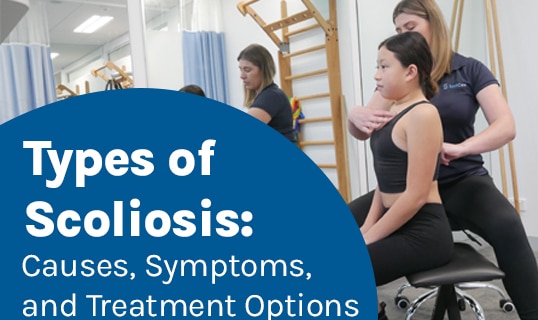Scoliosis ranges in severity from mild to moderate and severe; it’s important to understand the different scoliosis severity levels because, as a progressive condition, the nature of scoliosis is to change over time. Moderate scoliosis symptoms are more noticeable than those associated with mild scoliosis, which is why many patients are diagnosed during the moderate stage.
Moderate scoliosis is diagnosed if an unnatural sideways-bending and rotating spinal curve that measures between 25 and 40 degrees has developed. Scoliosis symptoms vary but commonly include postural changes and pain.
As a patient’s journey with scoliosis starts with a diagnosis, let’s discuss how moderate scoliosis is diagnosed.
Assessing and Diagnosing Scoliosis
The first step to successful treatment is a comprehensive initial assessment.
Initially assessing a patient for scoliosis means checking for condition indicators that warrant the need for further testing.
An initial assessment will involve taking the patient’s family history and conducting a physical examination, including an Adams forward bend test. (1)
A family history is considered a risk factor, and when examining the spine and trunk while the patient is in a forward-bend position, the spine and related trunk asymmetries are highly visible, and if the examination finds indicators of scoliosis, a scoliosis X-ray is the next step.
The only way to really know what’s happening in and around the spine is an X-ray, and X-ray results are needed to diagnose scoliosis.
An X-ray has to confirm an unnatural sideways-bending spinal curve, but it also has to confirm that the spine doesn’t just bend unnaturally, but also twists (rotational component), and a number of measurements are taken to determine the amount of rotation and condition severity.
Condition Severity: Moderate Scoliosis
A person can be diagnosed with mild scoliosis, moderate scoliosis, or severe scoliosis, and mild to moderate and severe is also the condition’s progressive path.
So, as a progressive condition, even scoliosis that’s diagnosed as moderate can become severe over time, particularly if it’s not addressed with a proactive treatment plan.
 When it comes to treating progressive conditions like scoliosis, the timing of when treatment is started can be an important factor, and the sooner treatment is applied, the more likely it is that the patient will respond well. (1, 2)
When it comes to treating progressive conditions like scoliosis, the timing of when treatment is started can be an important factor, and the sooner treatment is applied, the more likely it is that the patient will respond well. (1, 2)
A measurement taken during X-ray known as Cobb angle indicates the size and severity of scoliosis; a moderate scoliosis curve requires a measurement of between 25 and 40 degrees.
Moderate Scoliosis Symptoms
Symptoms of scoliosis vary based on a number of factors including patient age, condition type, severity, and location within the spine.
The main symptoms of scoliosis in children involve postural changes.
As scoliosis causes the spine to bend and twist unnaturally, it’s not just disrupting the balance and stability of the spine, but also the entire body, particularly if progression is occurring, and this causes poor posture to develop.
In many cases, the earliest telltale signs of scoliosis are uneven shoulders and uneven hips, with one shoulder sitting higher than the other, one shoulder blade protruding more on one side than the other, and one hip sitting higher than the other (1).
Additional changes can include the development of a rib hump where one side of the rib cage is protruding more, an uneven waist with one side sitting higher than the other, and at the moderate level, changes to movement can also develop.
Patients with moderate scoliosis can experience disruptions to balance and coordination, and as postural changes cause the body to shift further out of alignment, changes to gait are also common; when the head is not centered over the torso, it’s also not centered over the pelvis, and the body being out of balance can cause an uneconomical gait to develop.
In adults, the main symptom of moderate scoliosis is pain. Adults also experience postural changes, but the more-noticeable symptom that leads adult patients to seek assessment and diagnosis is pain caused by compression.
Moderate scoliosis pain can involve sore, strained, and unbalanced muscles, back pain, and radiating nerve pain.
Childhood scoliosis isn’t often described as painful because scoliosis doesn’t become compressive until growth has stopped and skeletal maturity is fully reached (2).
Moderate Scoliosis Treatment Options
A diagnosis of moderate scoliosis should be taken seriously because, without treatment, it can progress, and this can limit the potential success of nonsurgical treatment options.
Surgical treatment can be recommended for severe cases, but spinal fusion surgery is invasive and can shape the spine’s long-term health differently than nonsurgical treatment (4).
Here at ScoliCare, the treatment focus is patient-centered and nonsurgical; we want to help patients avoid the challenges associated with progression and invasive surgical treatment.
In many cases, scoliosis is highly treatable and responsive to less-invasive treatment options, particularly when applied early.
Nonsurgical scoliosis treatment is innovative and integrative; it combines the power of corrective scoliosis bracing and scoliosis-specific exercise programs (5).
Corrective Bracing and the ScoliBrace®
Scoliosis bracing plays an integral role in the nonsurgical treatment of scoliosis in patients of all ages, and there is a big difference between the potential efficacy of traditional scoliosis braces and modern corrective scoliosis braces (5).
Remember, as a spine affected by scoliosis doesn’t just bend unnaturally but also twists, it’s a 3-dimensional condition, so treatment has to address it as such.
Traditional scoliosis braces are 2-dimensional so are limited in their potential efficacy; in addition, their design is based on a 3-point pressure system that squeezes the spine into a straighter alignment, and this is known to weaken the spine over time (5).
ScoliBrace®
Modern corrective bracing has learned from the limitations of traditional bracing options, and the ScoliBrace® has become the world’s most advanced brace offering potential 3-dimensional corrective results.
The ScoliBrace® uses advanced scanning software to ensure that each brace is 100-percent customized to suit a patient’s body and condition type, and this makes it more comfortable to wear and addresses the main challenge of scoliosis bracing: compliance.

Research confirms the place of bracing in scoliosis treatment, and as growing spines are more flexible, they can be highly responsive when braces are worn as prescribed, so bracing plays an integral role in childhood scoliosis treatment (3,5).
The ScoliBrace® positions the spine into an overcorrected position, and the goal of bracing in adolescents is to manage progression over periods of rapid growth: counteracting the condition’s progressive nature.
The ScoliBrace® can be prescribed for full- or part-time wear and can complement scoliosis-specific rehabilitation efforts.
ScoliBalance®
ScoliBalance® is ScoliCare’s highly specialized scoliosis-specific exercise program used to treat scoliosis and further rehabilitate the spine (5).
ScoliBalance® seeks to restore balance to the spine and body.
ScoliBalance® is a physiotherapeutic scoliosis-specific exercise program that integrates physical therapy, chiropractic, and exercise rehabilitation; combining different treatment disciplines means being able to apportion them accordingly and customize treatment plans fully.
Together, these facets of treatment can impact conditions in all three dimensions for true corrective results.
ScoliBalance® designs exercise programs for patients based on their individual symptoms, curve types, and posture, and many exercises are performed in front of the mirror so patients are taught postural awareness and remodeling
Patients can then carry the knowledge and practice of mindful body positioning into their daily lives and activities.
ScoliBalance® can help reduce curve size and pain, increase spinal flexibility, and improve muscular balance and strength for better support/stability for the spine (5).
ScoliBalance® uses the same 3-dimensional approach as ScoliBrace®, so they work together to address an unnatural curvature of the spine (5).
Conclusion
The ScoliCare approach is nonsurgical, proactive, and integrative; it combines the power of multiple treatment disciplines so conditions can be impacted on every level.
A diagnosis of moderate scoliosis is given if the spine bends to the side, twists, and has a Cobb angle measurement of between 25 and 40 degrees; the best way to prevent moderate scoliosis from becoming severe is through proactive treatment options.
Many patients are diagnosed with moderate scoliosis, and this is because the symptoms of mild scoliosis can be too subtle to notice, but once mild scoliosis has progressed to moderate scoliosis, more noticeable symptoms can develop.
Common symptoms of moderate scoliosis include postural changes such as uneven shoulders, shoulder blades, hips, a rib cage hump, and an uneven waist.
Changes to gait, balance, and coordination are also common as the spine becomes increasingly unbalanced.
For adults, pain is the main symptom of moderate scoliosis, and this can involve muscle pain, back pain, and/or pain that radiates into the extremities due to compressed nerves.
Scoliosis patients need to understand that as a progressive condition, if left untreated, moderate scoliosis is likely to become severe scoliosis, and this means more severe symptoms and the potential need for more invasive forms of treatment.
When treated proactively, scoliosis can be highly responsive; scoliosis-related pain and progression can be managed, curvature reductions may be possible, and improving the spine’s surrounding muscle balance and strength means more support and stability for the spine.
References:
- Screening for the Early Detection of Idiopathic Scoliosis in Adolescents: American Academy of Orthopaedic Surgeons
- Active self-correction and task-oriented exercises reduce spinal deformity and improve quality of life in subjects with mild adolescent idiopathic scoliosis: National Library of Medicine
- Weinstein SL. The Natural History of Adolescent Idiopathic Scoliosis. J Pediatr Orthop. 2019 Jul;39(Issue 6, Supplement 1 Suppl 1):S44-S46. doi: 10.1097/BPO.0000000000001350. PMID: 31169647.
- Comparison of Functional Outcome and Quality of Life in Patients With Idiopathic Scoliosis Treated by Spinal Fusion: National Library of Medicine
- Marchese R, Du Plessis J, Pooke T, McAviney J. The Improvement of Trunk Muscle Endurance in Adolescents with Idiopathic Scoliosis Treated with ScoliBrace® and the ScoliBalance® Exercise Approach. J Clin Med. 2024 Jan 23;13(3):653. doi: 10.3390/jcm13030653. PMID: 38337346; PMCID: PMC10856658.


